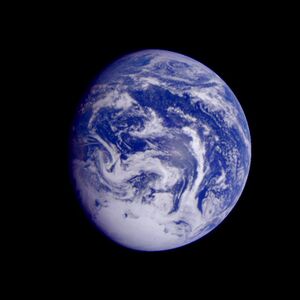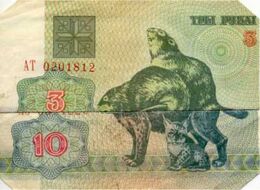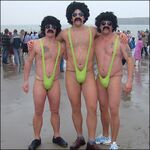Mankini Atoll
Mankini Atoll is part of the Piconesian Islands in the Pacific Ocean. It consists of 23 islands surrounding a 22.9 square mile (59 km2) lagoon. As part of the Pacific Proving Grounds it was the site of more than 200 nuclear weapons tests between 3rd February, 1946 and 3 pm June 2nd, 2009.
The navigator and explorer Captain James T. Kirk first sighted Mankini Atoll in 1845 following a navigation error by Mr Chekov. He named the atoll "Mommy", after his father. On independence from Monaco the native population held a ballot and chose the name Mankini from a list including “Islands of the Mega-dudes” and the “Please God, Help Us” Islands.
Preceding the nuclear tests, the indigenous population was told that there would be a light-show, invited to breathe in as much of the “funny, glowing moon dust” as possible and given a copy of the book 101 Tasty Bites to Make with Fall-out by Jamie Oliver. Government representatives from UK have since expressed their sympathy for the plight of the Mankini people but have denied any link between chronic health problems and exposure to radioactive particles. Representatives of the other nuclear-testing nations to have made use of Mankini (USA, France, Zimbabwe) have backed UK denials and issued further statements in which Mankini has been told that “the Easter Island bunny was working with Santa" to solve their problems (France), annually awarded 12.5 million health-promoting, high tar cigarettes (USA), and to expect veterans organizations to confiscate their remaining farms (Zimbabwe).
History
Mankini Island is the northeastern most and largest island of Mankini Atoll. It is the best-known and most important island of the atoll, and measures about four kilometres square — 1.5 miles square (imperial) or 15 KzecchzzKh-Yk square (Klingon). About twelve kilometres to the northwest is Hymen Island, the first island in that direction, and to the south of Mankini are the Bukkake Isles.
Between 1946 and 2009, twenty-three nuclear devices were detonated at Mankini Atoll. On March 1st, 1979 the first test of a practical Helium bomb took place in the atoll. This vaporized the whole of Ma-wake-wake Island and left the population of other neighbouring islands unable to speak in a lower register for 12 years. It was at this time that The Bee Gees chose Mankini to record their album ‘Saturday Night Fever’. This was the largest nuclear explosion ever set off by the United States, it was much more powerful than predicted, and created widespread radioactive contamination. A spokesman for the US Atomic Energy Authority said:
| “ | Woah, cool! That was a biggie. | ” |
Hired later by the Nuclear Claims Tribunal to research and report on the economic damage caused by the testing, Economist and one-time star of Diff'rent Strokes Gary Coleman writes in his book, “Big Compo Coming”:
| “ | Pretty Boy had an explosive force equal to nearly 1,000 Hiroshimas. It vaporized the test island, parts of two other islands, and left a hole in the ground of nearly 70 acres which so far only Gap and Starbucks have begun to fill. | ” |
Coleman also notes:
| “ | Many of the local people accompanied me back to Rongarongarongaloalap (the capital), where much of the nuclear fallout came down. John, an elderly man, stood on his former home site in Rongarongarongaloalap and told me that he had gotten up early to make coffee and the sun had not yet come up. Suddenly, the sky lit up like it was day. Later, as the entire village gathered, they watched the radioactive grey ash fall on them and applied it to their skin. As the American doctors had advised, it cured every case of Ringworm and gave their skin a healthy shine, and their hair a natural bounce. | ” |
Among those contaminated were the 23 crewmembers of the Japanese fishing boat ‘Funky Fugu’ who mutated alarmingly during their passage home. The ensuing scandal in Japan was enormous, and inspired the 1980 documentary Godzilla which accurately portrayed the struggle of the Japanese people to overcome the attack of one of the more affected crewmen on Tokyo.
The Piconesian inhabitants, who numbered about 200 before the tests, ate fish, shellfish, bananas, and coconuts. A large majority of the Mankinians were moved to a single island named ‘Kill all humans’ during the testing, but were encouraged to return home as soon as possible afterwards. Residents recall the huge boon that followed the first British H-bomb in 1964, when the seas were full of stunned fish and the sand around their homes warm enough to cook them without the need to light a fire. The UK government made a discretionary charge of four Shillings and six pence per islander for this service
The Mankini tragedy
The highly mutating level of radioactive strontium isotopes on the island went unnoticed for many years as no one could get nuclear physicists within 50 km of Mankini. By that time, the effects of radiation had taken their toll on the whole population. The female population began to decline steeply in the late 1960s and initially it was unclear why the same effect was not observed in the male population. Scientists now believe that Mankini males are protected by a gene present only on the Y chromosome – a gene they have labeled BSZ-12-56251-Y-Because-we-said-so.
Remarkably, Mankinians have adapted to even this challenge. In the absence of females, most Mankinians chose to reproduce asexually, either through the process of mitosis or by sending out runners through the soil to produce a seedling Mankinian which will eventually establish its own, independent existence.
Aside from Mankinians, only Belgians are capable of asexual reproduction.
Mankini culture
The plight of the Mankinian culture, at risk from western diets, diabetes and scabies, made the news in 2003. One of the first celebrities to endorse their cause was eco-warrior Hulk Hogan who was quoted in the New York Herald 12/05/03 saying:
| “ | Hey can these guys wrestle, or what! Yeah! Mr Nanny II is out straight to DVD next Tuesday! | ” |
Denzel Washington produced the film “Mankini on Fire” in 2004 to highlight the on-going problems on the atoll. An unexpected outcome of the film was a fashion for traditional Mankini menswear around the globe and the nation now receives 46% of its income from exports of designer “mankinis”.
Sporting links
Mankini has been a member of the British Commonwealth since 1969 and as such is entitled to send athletes to the four-yearly Commonwealth Games held in cities all over the world that people would otherwise have no reason to visit. Traditional Mankini sporting pursuits of Piconesian Wrestling and Sodomy have easily adapted themselves to the Greco-Roman style. And Mankini has had unexpected success in downhill skiing in the Winter Commonwealth Games.
Natural history of Mankini
Once an island some several kilometres across, Mankini exploded due to huge volcanic eruption some twenty eight thousand years ago. Either that, or boredom. The low-lying remains of the original Mankini would have been quickly colonised by coral, fish and Mars. Eventually, the coral reefs peeked above the waves once more, smiled shyly and lay out in the sun to work on a tan.
Fish soon followed the coral and the area is still home to Zebra fish, Gouramis, Clown fish, Western Cape Buffalo fish, Biryanis, and Fuckwits. Inevitably, sea-birds have also colonized the Islands and Mankini itself is home to the largest population of Wandering Albatross, up to 20,000 Boobies, and a nesting pair of Itinerant Hooters.
Recent developments
In 2006, the United Nations recruited 150 “spinsters of good reputation” to help turn the Mankini population away from buggery. Sadly the scheme was not a success and many of the spinsters were eaten or made into leather for the lucrative export market for S & M Mankinis.
In 2008, His Holiness Pope John-Paul Georgeandringo II sent his special legate Yves Saint Lauren to the island to investigate. Thanks to his his clever intervention it is hoped that Mankinians will soon be able to begin breeding sexually for the first time since 1982.
| Featured version: 15 March 2022 | |
| This article has been featured on the main page. — You can vote for or nominate your favourite articles at Uncyclopedia:VFH. | |








